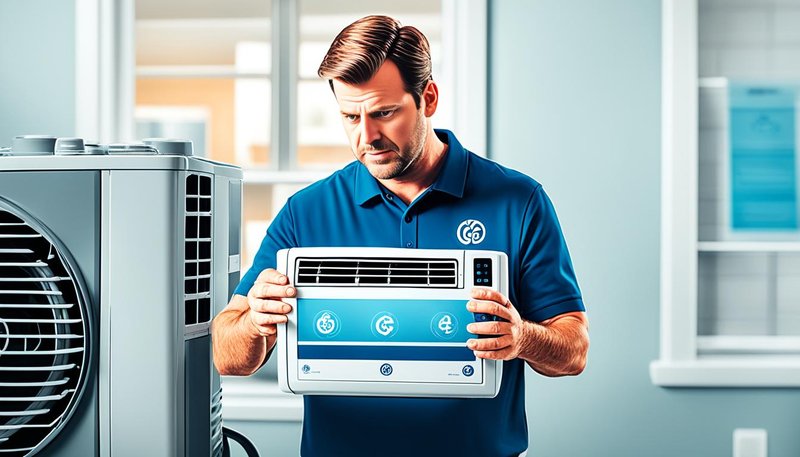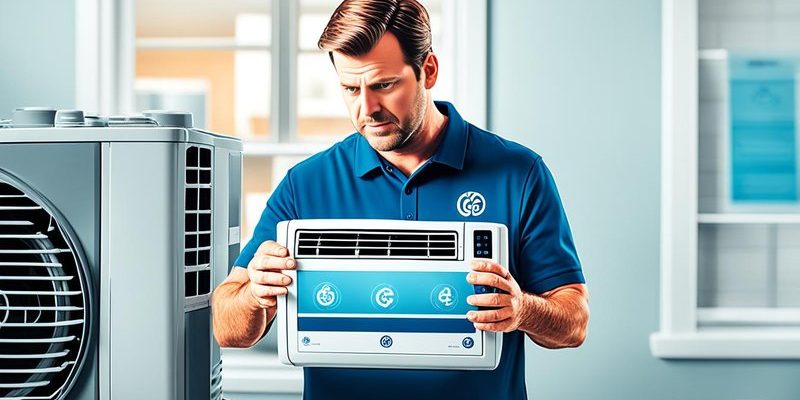
Let’s face it—these remotes are like the “gatekeepers” to your comfort in summer. Lose their trust, and it’s back to wrestling with buttons on the main unit—usually while sweating buckets. The good news? Most remote issues are simple to fix with a little patience and some basic know-how. Whether you’ve got one of those classic GE chip remotes or the more modern, sleeker models, you’ll see that almost all fixes follow the same playbook. Here’s how to get your cool back without breaking a sweat.
Check the Batteries First—Seriously, Don’t Skip This
You’d be surprised how many remote control issues boil down to weak or dead batteries. It sounds obvious, but I can’t tell you how many times I’ve nearly lost my sanity only to realize I needed a couple of fresh AAAs. Your GE AC remote won’t work if the batteries are on their last legs, plain and simple.
Here’s the thing: sometimes even brand-new batteries can be duds or inserted the wrong way around. Flip the remote over, slide off the battery cover, and make sure the batteries are snug and oriented correctly. If you have a battery tester (fancy!), use it. Otherwise, just swap in a new set. When everything inside looks clean—no corrosion or weird gunk on the contacts—you’re good to go.
What if you change the batteries and it still acts up? Give those contacts a gentle rub with a dry cloth. Any residue or buildup can block the flow of power. I once rescued an old remote by just cleaning the contacts—felt like a hero.
Inspect the Remote’s Infrared Signal
GE AC remotes talk to the air conditioner using invisible light. I know, it sounds sci-fi, but it’s just regular infrared (IR) light. The trouble is, unlike your phone screen, you can’t see if it’s actually “blinking.” So, how do you check if the remote’s sending a signal? Your smartphone camera is your secret weapon here.
Here’s how I do it: open your camera app, point the remote’s “eye” (the little dark bulb at the front) at the camera, and press any button. If you see a faint flashing light on your phone screen, the remote’s sending an IR code. No flash? The remote isn’t talking to the AC, so the issue might be inside the remote itself.
Sometimes dirt or scratches on the IR “eye” can block the signal too. Give it a wipe with a soft, dry cloth. If your remote’s been dropped (we’ve all done it), the IR bulb could be knocked loose inside. Unless you’re handy with a tiny screwdriver, you might need a replacement or professional help.
Sync and Pair the Remote with Your GE AC Unit
You might be wondering: do I really need to “pair” my remote to my AC? For most GE models, the answer is yes—especially if you’re using a universal remote, or if your original remote got unsynced for some reason.
Syncing is usually a breeze. First, make sure nothing’s blocking the path between the remote and the AC unit. Stand close (not across the room), then press the “Power” and “Mode” buttons together for a few seconds. Some GE remotes require you to hold down the “Reset” or “Set” button. When you hear a beep from the AC or see the display flicker, you’re good—it means the code worked and they’re paired up.
When I switched to a universal remote after losing my original GE one, I spent ten minutes entering the wrong code. Turns out, the right sync code was on a sticker inside the battery compartment. Always check there if you’re stumped!
If your AC doesn’t respond, try entering the manufacturer’s code (found in your remote’s manual or online). Still nothing? It’s worth resetting the remote (yep, that comes next).
Resetting Your GE AC Remote—The Power of a Fresh Start
Sometimes remotes just need a clean slate. Maybe they got confused by a power outage, or you mashed too many buttons at once. Good news—resetting a GE AC remote is typically quick and painless.
Here’s my go-to trick: pop out the batteries, wait 30 seconds (count slowly—it feels like forever), then hold down the “Power” button for another 10 seconds with no batteries inside. This can flush out any lingering static or memory errors. Put the batteries back in, and you should see the display come back to life.
On some remotes, there’s a tiny pinhole labeled “Reset.” Gently poke it with a paperclip for a few seconds. This will force the remote to reload its internal code, just like restarting your smartphone. Resetting can also help if the buttons have become unresponsive or stuck on the wrong setting.
Fun fact: I once fixed an “unfixable” remote with a reset after trying literally everything else. When in doubt, give it a fresh start.
Button Issues: Stuck, Unresponsive, or Acting Weird?
Remote buttons take a lot of abuse—spilled drinks, greasy fingers, the occasional toddler attack. Over time, buttons can stick, stop clicking, or worse, activate the wrong function. That’s annoying when all you want is cooler air, not a surprise blast of heat.
Start by pressing each button slowly, one by one. Does any button feel squishy or stuck? Try pressing it gently a few dozen times to loosen up any grime lodged underneath. If it’s still stubborn, a soft toothbrush or cotton swab around the edge can help clear crumbs or dust.
Still not working right? Sometimes the silicone pad inside the remote wears out or loses contact with the circuit board. This is tricky to fix yourself unless you like tiny DIY surgery, but if you’re desperate, you can carefully open the back and clean it with isopropyl alcohol. Just be careful not to lose any pieces! If all else fails, it might be time for a replacement.
Check for Interference and Obstructions
You might not realize it, but a surprisingly tiny thing can mess with your GE remote’s signal. I once spent an hour convinced my remote was toast, only to realize a decorative plant was blocking the AC sensor. True story.
Make sure nothing’s in the way—books, curtains, furniture, or (oddly enough) sunlight can all block or bounce IR signals. Even the angle matters; try pointing the remote straight at the AC’s sensor, not at the ceiling or off to the side. Bright lights or electronic devices like TVs, routers, or even other remotes can sometimes “jam” the signal too.
If you’re in a room full of gadgets (who isn’t these days?), try turning some off and testing the remote again. Move closer to the AC and see if things improve. Sometimes, it’s as simple as getting rid of whatever’s in between—seriously, don’t underestimate a chunky coffee table’s blocking power.
Is It the Remote—or the AC Unit?
Here’s where things get tricky: sometimes, the problem isn’t with the remote at all. If you’ve tried new batteries, resets, and everything else and still get no joy, the AC’s own sensor might be having a rough day.
Look at the AC unit’s display—any weird flashes or missing icons? Try using the buttons directly on the air conditioner. If these don’t work either, it’s likely a problem with the AC itself (not the remote). In that case, check the unit’s power source, circuit breakers, or even the wall outlet. Sometimes a quick unplug-and-replug can get things humming again.
If the main unit works with its own buttons but not the remote, the AC might need a sensor cleaning. You can use a soft, dry cloth to polish the sensor—it’s usually a small black window on the front panel. If that fails, you might need to call in a pro or consider a universal remote as a workaround.
Universal vs. Brand Remotes—Should You Make the Switch?
When your GE AC remote goes totally dark and nothing brings it back, you might be tempted to try a universal remote. These are like the “Swiss Army knives” of remotes and can often work with a bunch of different air conditioners. But here’s the catch: not all universal remotes sync perfectly with GE models.
Check the packaging or the online listing to make sure it supports GE air conditioner codes. Some universals need you to input a code (found in their manual) or “learn” by copying your old remote. If your GE remote is officially out of production and Amazon’s got a hundred knockoff options, read the reviews—sometimes the cheaper ones are a headache.
Honestly, I tried a universal when my GE remote died, and it saved me months of fidgeting with a broken remote. Just be patient with the setup—it can take a couple of tries to get all your settings working right.
If you can find an official GE replacement remote, that’s usually the safest bet for full functionality, especially for modes like “Eco,” “Sleep,” or timers. But if price or availability is an issue, a universal remote can be a solid backup plan.
When to Call for Help or Replace Your Remote
Look, sometimes remotes just give up the ghost. If you’ve tried all the troubleshooting steps—fresh batteries, resets, checking signals, cleaning buttons and sensors—and you still can’t get your GE AC remote to work, it’s probably time to move on.
Replacement remotes can be found through GE’s website, appliance stores, or reputable online sellers. Double-check the model number on the back of your AC or the original remote to make sure you get the right one. If your AC unit itself is glitchy, making odd noises, or failing to respond to both the remote and manual controls, consider bringing in a technician. Some issues are just above our DIY pay grade.
For the tech-savvy, there are also smartphone apps and smart home devices that can control GE air conditioners via WiFi—but that’s a bigger step and usually only works on newer models. If your AC is vintage (like, pre-WiFi era), a replacement remote or universal is the safer bet.
A little troubleshooting can save a ton of frustration—but don’t blame yourself if you can’t fix it all at home. Sometimes gadgets have a mind of their own.
Wrapping up, fixing your GE AC remote is usually just a matter of patience and a few smart checks. Start with the basics, take your time, and don’t be afraid to try more than once. After all, nothing beats the sweet relief of cold air on a hot day—with a remote that finally listens.
